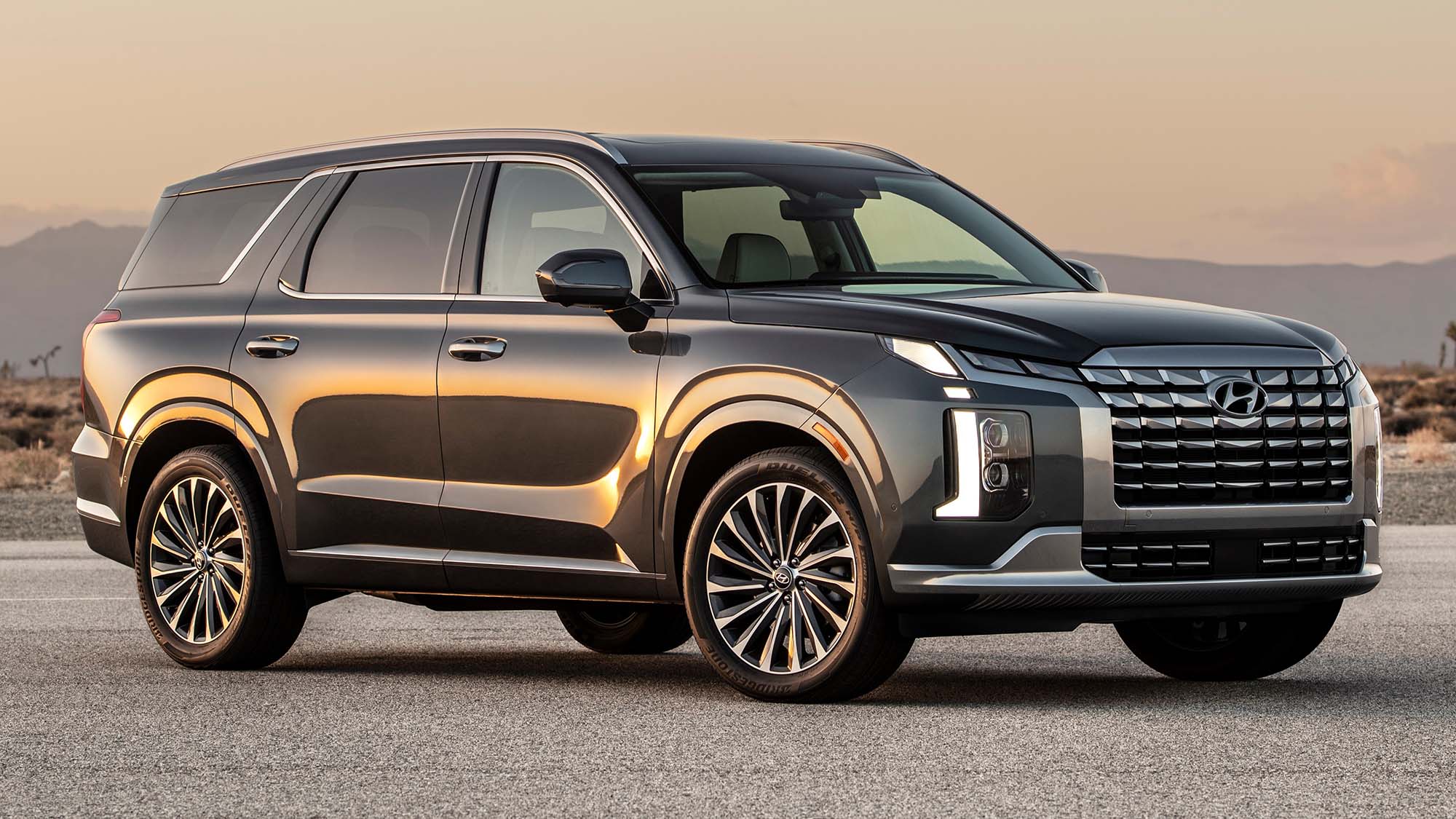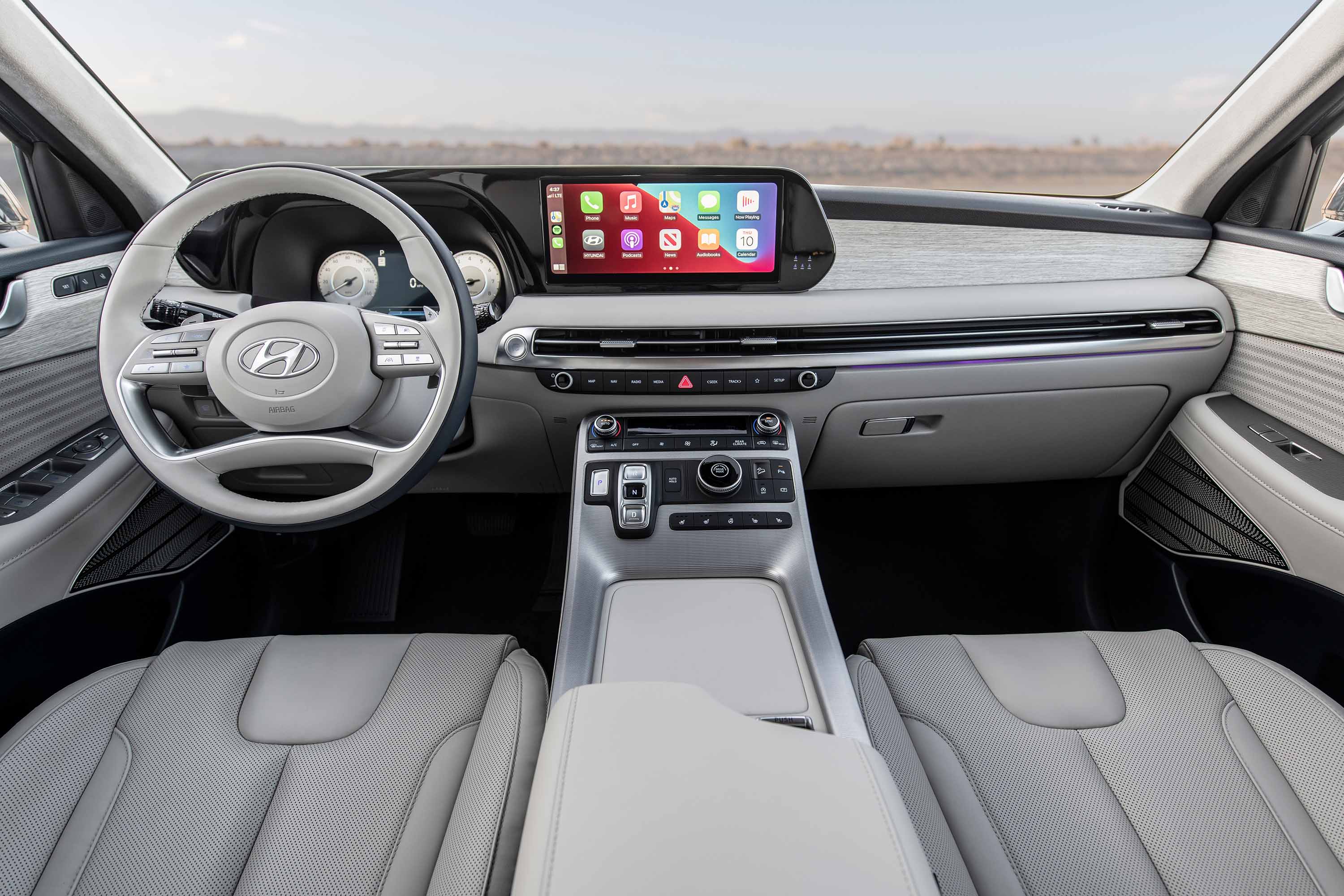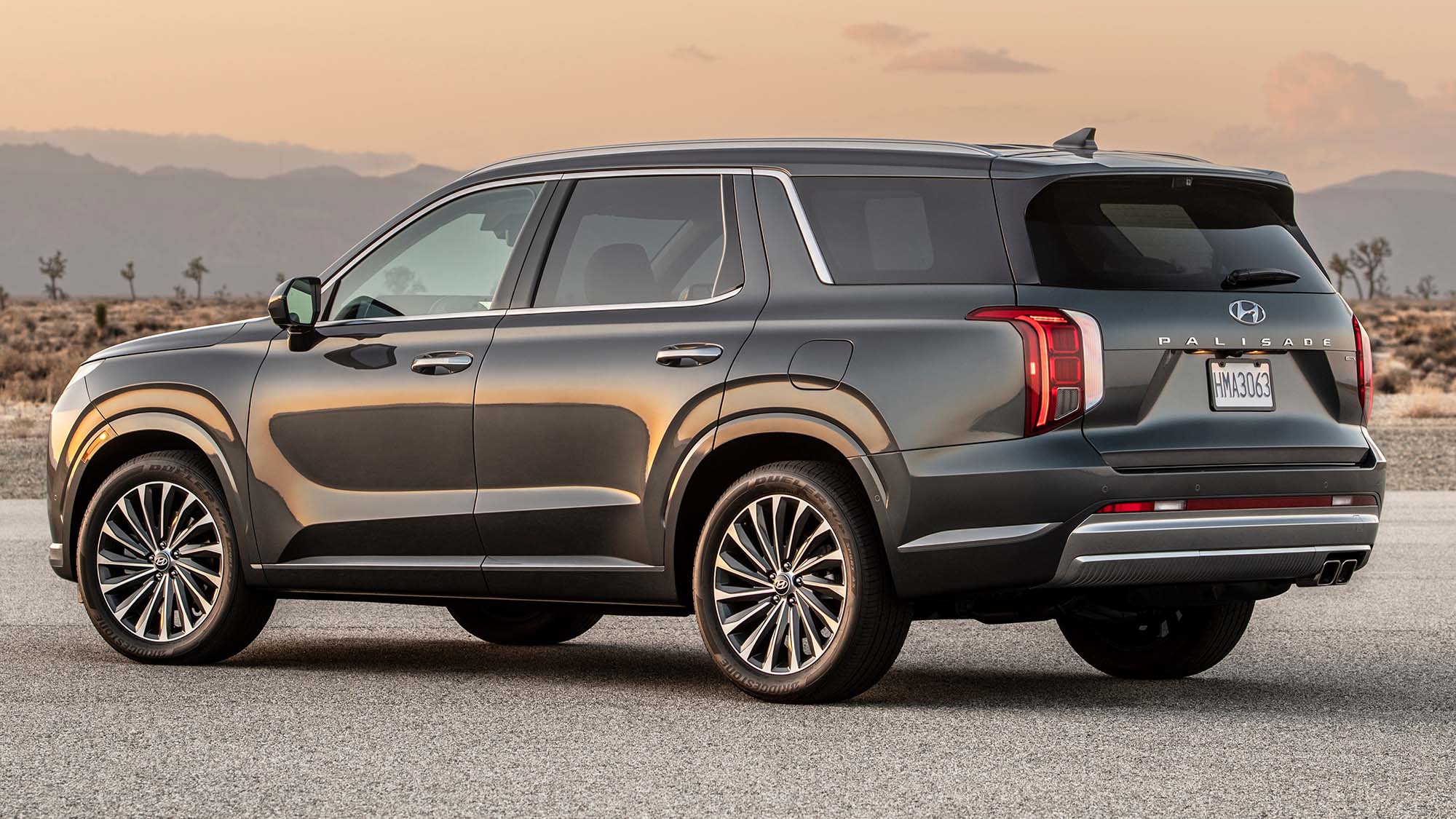2023 Hyundai Palisade
Business As Usual For Hyundai
Even after spinning Genesis off as a unique luxury division, Hyundai has continued to march their own brand more and more in that direction. 2020’s Palisade was not only their most luxurious suv yet, but also their biggest. And if we’ve learned nothing else this century, it’s that Hyundai doesn’t stand pat for long. So, for 2023 the Palisade gets a host of updates that make it more appealing than ever!
 While it didn’t exactly come out of nowhere, it’s doubtful many people thought that the Hyundai Palisade would become as popular as it has in just 3 short years. And with popularity comes higher expectations of customers, but also an increased effort on the side of the manufacturer to deliver even more. That’s where this 2023 Hyundai Palisade comes in; not only highlighting numerous exterior updates, but changes in technology for both convenience and driving assistance.
While it didn’t exactly come out of nowhere, it’s doubtful many people thought that the Hyundai Palisade would become as popular as it has in just 3 short years. And with popularity comes higher expectations of customers, but also an increased effort on the side of the manufacturer to deliver even more. That’s where this 2023 Hyundai Palisade comes in; not only highlighting numerous exterior updates, but changes in technology for both convenience and driving assistance.
It’s hard to miss that cascading grille; it’s bigger, yes, but also with more sophisticated, upscale styling. Both the headlamps and daytime running lights have been redesigned to blend into surroundings a little more than before; and there are new wheel designs throughout the lineup; these 20-inch multi-spoke alloys specific to top Calligraphy trim. Additional features such as auto-dimming side mirrors have also been added.
When it comes to the interior, most of what you interact with has also been updated. There’s a new dash that appears leaner and more linear, with slimmer control panels that are also more digital than before; as well as a larger housing for the 12-inch infotainment display. It still blends into the gauge cluster as before, but now does so more smoothly. There’s a new steering wheel with updated controls, nicer materials throughout the cabin, and wireless phone charging increases from 5 to 15-watts.
Lots of updates in the 7 or 8 passenger seating areas too. Front seats get new covers made of finer materials. Our tester’s second-row captain’s chairs get adjustable armrests, and 3rd row seats can now be heated.
 Front seats are still not as plush feeling as some but are definitely all-around comfortable for long trips. Second-row room is generous, there’s quick and easy access to the standard third row, and dual sunroofs allow in lots of natural light. And we love the wealth of small item storage places front to back. Cargo space remains a very plentiful 18.0 cubic-ft. behind the 3rd row, 45.8 behind the 2nd, and a max of 86.4 behind the front seats.
Front seats are still not as plush feeling as some but are definitely all-around comfortable for long trips. Second-row room is generous, there’s quick and easy access to the standard third row, and dual sunroofs allow in lots of natural light. And we love the wealth of small item storage places front to back. Cargo space remains a very plentiful 18.0 cubic-ft. behind the 3rd row, 45.8 behind the 2nd, and a max of 86.4 behind the front seats.
Powertrain is unchanged; that means a 3.8-liter V6 and 8-speed automatic transmission delivering 291-horsepower and 262 lb-ft. of torque, but we felt a trip to Mason Dixon Dragway was still in order.
Traction was good off the line, leaving with just a slight chirp of the tires, and delivering steady power almost immediately. Still, this is a big vehicle, so taking a full 7.0-seconds to hit 60 is not out of line by any means. The 8-speed automatic worked smoothly, ripping through 1st and 2nd gears quickly, while taking its time with 3rd and 4th; helping the Palisade complete the ¼-mile in 15.3-seconds at 92 miles-per-hour.
It felt good in our handling course too, with moderately weighted steering feel and only minor amounts of understeer. Body roll was moderate, but it was easy to keep a smooth consistent pace through the cones, with very little stability control intervention, and no drama to speak of. A new tow mode has been added to bring drive mode options to 7, allowing the transmission to hold onto gears a little longer, but max towing capability remains at 5,000-lbs. It’s integrated into Hyundai’s active HTRAC all-wheel-drive system which is available in all trims and uses selective braking not only to enhance traction in slippery situations but provide handling benefits by helping the vehicle rotate through turns. Brakes were quite good as well despite a very soft pedal; only moderate nosedive, with straight and smooth stops of just 108-feet from 60.
 Safety and driver assistance technology also get upgraded, along with added Remote Smart Parking Assist and enhanced Highway Driving Assist. And finally, Hyundai follows the trend of off-road inspired utilities with a new toughened up XRT trim.
Safety and driver assistance technology also get upgraded, along with added Remote Smart Parking Assist and enhanced Highway Driving Assist. And finally, Hyundai follows the trend of off-road inspired utilities with a new toughened up XRT trim.
Pricing starts at just $36,545, with top Calligraphy coming in at only $50,495. All-wheel-drive is a $1,900 option with all trims.
So, a lot of little and some not so little things have changed about the 2023 Hyundai Palisade 3-row SUV. But, the most important thing of all hasn’t changed. That is, the Palisade continues to deliver an amazing amount of luxury, practicality, and comfort at a quite attainable price. Sounds like business as usual for Hyundai.
Specifications
- Engine: 3.8L V6
- Horsepower: 291
- Torque: 262 lb-ft
- 0-60 mph: 7.0 seconds
- 1/4 Mile: 15.3 seconds at 92 mph
- 60-0 Braking: 108 feet (avg)
- EPA: 19 City / 25 Highway / 21 Combined
- MW Fuel Economy: 24.9 mpg
2025 Volkswagen ID. Buzz
Volkswagen Brings Beetlemania Level Of Excitement To Minivan Segment
The duty of upholding Volkswagen’s heritage has most recently been delegated to small legacy car names like Golf and Jetta. But hold on! A much larger, totally modern take on VW’s classic microbus has just buzzed over the horizon— the all-electric ID. Buzz. It’s been at the top of our minds since we first saw the concept back in 2017. Well, it’s finally here, so let’s get our groove into drive!
This 2025 Volkswagen ID. Buzz has indeed created the most buzz around Volkswagen since the Beetle’s return to the U.S. in the late 1990s. We couldn’t drive it anywhere without drawing a crowd. No wonder, just about everyone has a VW Microbus story to tell, and seeing this reimagined version rolling down the street brings back all those memories.
VW really pulled it off as far as we’re concerned, as it looks great without appearing over the top. All the cues are here: Big VW logo front and center, lots of greenhouse including A-pillar windows and mini sliders for the second-row passengers, D-pillar air vents, and two-tone wheels. And while its appearance may be pure retro, its drivetrain is far from it, as the ID. Buzz is all-electric, and unlike the new Beetle, the Buzz does retain the original Microbus’ rear-drive architecture.
Powering those rear wheels is a 210-kW motor drawing juice from a 91-kWh battery for a range of 234 miles; 200-kW max charging will get you to 80% in about 26 minutes. Buyers can add another small 80-kW motor up front for 4motion all-wheel-drive and an increase of total output from 282 to 335 horsepower with a combined 512 lb-ft of torque. It uses the same battery, but range estimates drop just slightly to 231 miles. But while those numbers are modest, we also found them to be quite conservative, as we observed as many as 287 miles available in our all-wheel-drive tester’s gauge display and were on pace for 273 miles in our driving loop.
One throwback theme that may be a turnoff to some is that it’s quite a step up into the Buzz’s front seats, but there’s certainly a commanding view of the road once you climb in. Second row seating can be either a three-place bench or a pair of captain’s chairs, so there’s generous room for seven or six passengers. The captain’s chairs in our Pro S Plus offer good support and very easy access to the third row.
Lots of flexibility too with the option to simply fold the seats or remove them altogether.
With the sliding side doors and a wide opening rear hatch, there’s plenty of access for loading big sport utility amounts of cargo. Lots of flexibility too with the option to simply fold the seats or remove them altogether, and the ability to create a full-length flat floor with a rear cargo shelf that covers some handy removable storage bins. There’s 18.6 cubic-feet of space behind the third row, 75.5 behind the second, and a max of 145.5. That’s more than a Chevrolet Tahoe. For smaller items, there are lots of cubbies throughout the cabin, along with a standard Buzz Box that can be moved to multiple locations.
With a design that prioritizes retro form and modern function over aero efficiency, the 4motion equipped ID. Buzz earns a Fair efficiency rating, using 42-kWh of electricity per 100 miles, and we weren’t sure what to expect at our Mason Dixon test track.
What we found was great torque off the line and drama free launches to 60 in just 5.3 seconds. It was very stable at speed and power delivery stayed steady most of the way down the track until we reached about 90 mph, when it began to taper off just before we finished the quarter-mile in 14.0 seconds flat at 97 mph.
With 1,200-lbs. of battery weight nestled in its 127.5-inch wheelbase, the Buzz felt planted to the pavement through our handling course. There was quite a bit of body roll to deal with, but surprisingly little understeer. In panic braking runs, pedal response was inconsistent, feeling soft at times, pushing back hard at others; but through it all, results were quite good, stopping from 60 in an average of just 108 feet.
Three interior themes are available, this Dune is the brightest, featuring coastal inspired wood optic dash décor, “gray and clay” leatherette surfaces, and a high-mounted central 12.9-inch touchscreen. Pricing starts with a rear-wheel-drive Pro S at $61,545; this Pro S Plus begins at $65,045, add another $4,500 for 4motion, which brings a few extra features along with all-wheel drive.
Retro design with old-school VW charm, modern EV drivetrain, big SUV capacity merged with minivan flexibility; it all comes together in this 2025 Volkswagen ID. Buzz. It’s easily one of the coolest rides of the year and one that will likely keep Volkswagen dealers buzzing for years to come, and that’s something no other people and things mover can say.
Specifications
As Tested
- Motor Setup: Dual-Motor AWD
- Battery Size: 91-kWh
- Horsepower: 335
- Torque: 512 lb-ft
- EPA Range: 231 miles
- 0-60 mph: 5.3 seconds
- 1/4 Mile: 14.0 seconds at 97 mph
- Braking, 60-0: 108 feet
- MW Test Loop: ~ 273 miles













































